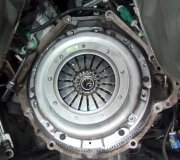Lots of good information. Thank you. You do not have to do the quick learn procedure. The computer will relearn the clutch volumes when you drive it, typically over a couple of miles or a dozen shift cycles. Quick learn is done by dealership mechanics to eliminate the need to do a long test drive after the battery was disconnected. It prevents customers from coming back with a complaint about the shifting characteristics, and the incorrect belief the mechanic did something to screw up their car.
On '95 and older cars, you can cycle the ignition switch from off to run three times within five seconds, (do not hit the crank position), then count the flashes of the Check Engine light. There will be a series of flashes, then a slight pause. The next series of flashes is the second digit of the two-digit code. After a longer pause, the second set of flashes are for the next code. Disregard a code 12 if you get it; that just means the ignition switch was turned off. After all the codes are read, the last one will be code 55. That just means it's done. Cycling the ignition switch once more will repeat the series.
On '96 and newer cars, this doesn't usually work because of the OBD2 system. You might see the codes listed in the odometer, but I can't remember. They should be four-digit codes in your car. Chances are the codes aren't related to the transmission. The Check Engine light is only turned on when the detected problem adversely affects tail pipe emissions. There can be other codes that don't cause the Check Engine light to come on. "Running cold too long" is a real common one up here in WI because on real cold days, the engine won't get to normal operating temperature within six minutes.
There are some transmission-related codes that will show up when accessing the engine computer, but it is more likely he will have to retrieve the codes from the transmission computer. I use Chrysler's DRB3 hand-held computer. Some of the better aftermarket scanners will do it now too, but I'm not very familiar with them.
I applaud your son's teacher for allowing him to rebuild this transmission. My former coworker, in a community college, is currently teaching his students how to remove the transmission, how to load it into a pickup truck, how to haul it to a transmission shop, how to pay the bill, how to haul it back, and how to install it! The students are very angry about not being prepared to enter the workforce.
What is the name and city of the school your son is attending?
One more note. Limp-in causes the transmission to stay in second gear until the ignition switch is cycled off and the engine is restarted. If it starts out in first gear, then defaults to second gear immediately after an upshift occurs, it is due to slippage in one of the clutch packs. In rare instances, that can be due to that clutch pack requiring more fluid to apply it than was pre-programmed in at the factory. After a few cycles, the computer will relearn that volume and start applying that gear just a little sooner before it releases the previous gear. That will maintain the solid shift feel. Normally this happens on high mileage transmissions where the clutch plates are worn so far, the computer can't increase fluid volume enough to keep up. A trick to overcome this until you can get to the repair shop is to accelerate harder than normal, then let off the gas just when it's ready to upshift into the problem gear. That will remove the torque / load on the clutch pack so it doesn't slip while it is engaging. Once it's solidly in gear, you can drive like normal.
If the transmission goes into limp-in as soon as you put it into drive, and it starts out in second gear, suspect a problem has been detected with a sensor or its wiring. It's something that was detected before clutch slippage ever had a chance to occur. There are two sensors on some cars that use the same style plug. Putting the plugs on the wrong sensors will not make the computer happy.
Before he pulls the transmission again, he should read the "CVI", that's the clutch volume index. It's a set of four values corresponding to the number of ccs of fluid needed to apply each clutch. If one is unusually high, since there are new clutch plates in it, suspect a piston seal got ripped or flipped over during installation. This can be found by applying the clutch pack with compressed air during the rebuilding process. If the fluid leakage from the front slows down or is intermittent, it might be nothing more than overfilled fluid. If the level is too high, it will get air whipped up in it from the rotating parts. Air in the fluid compresses and can lead to clutches not applying properly, and foaming fluid could reach the vent hole behind the torque converter. As I recall, it takes nine quarts to fill a minivan transmission. I would expect your car to take about the same amount.
I'm sure he replaced the front seal, but if not, they can get hard and brittle from heat and age. They don't cause a problem until the engine and transmission are separated, then the weight of the torque converter hanging down can crack the hardened seal. It's good practice to always replace it when buying a used transmission from the salvage yard when you don't know its history or mileage.
Caradiodoc
SPONSORED LINKS
Saturday, January 16th, 2010 AT 4:13 AM



